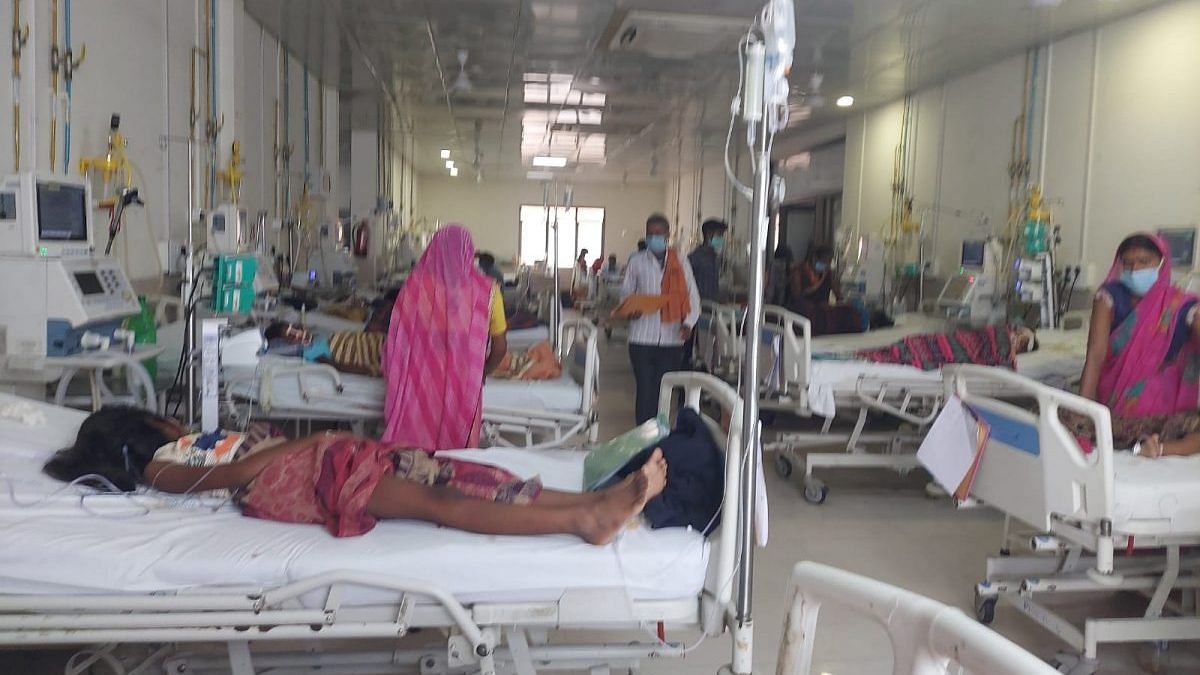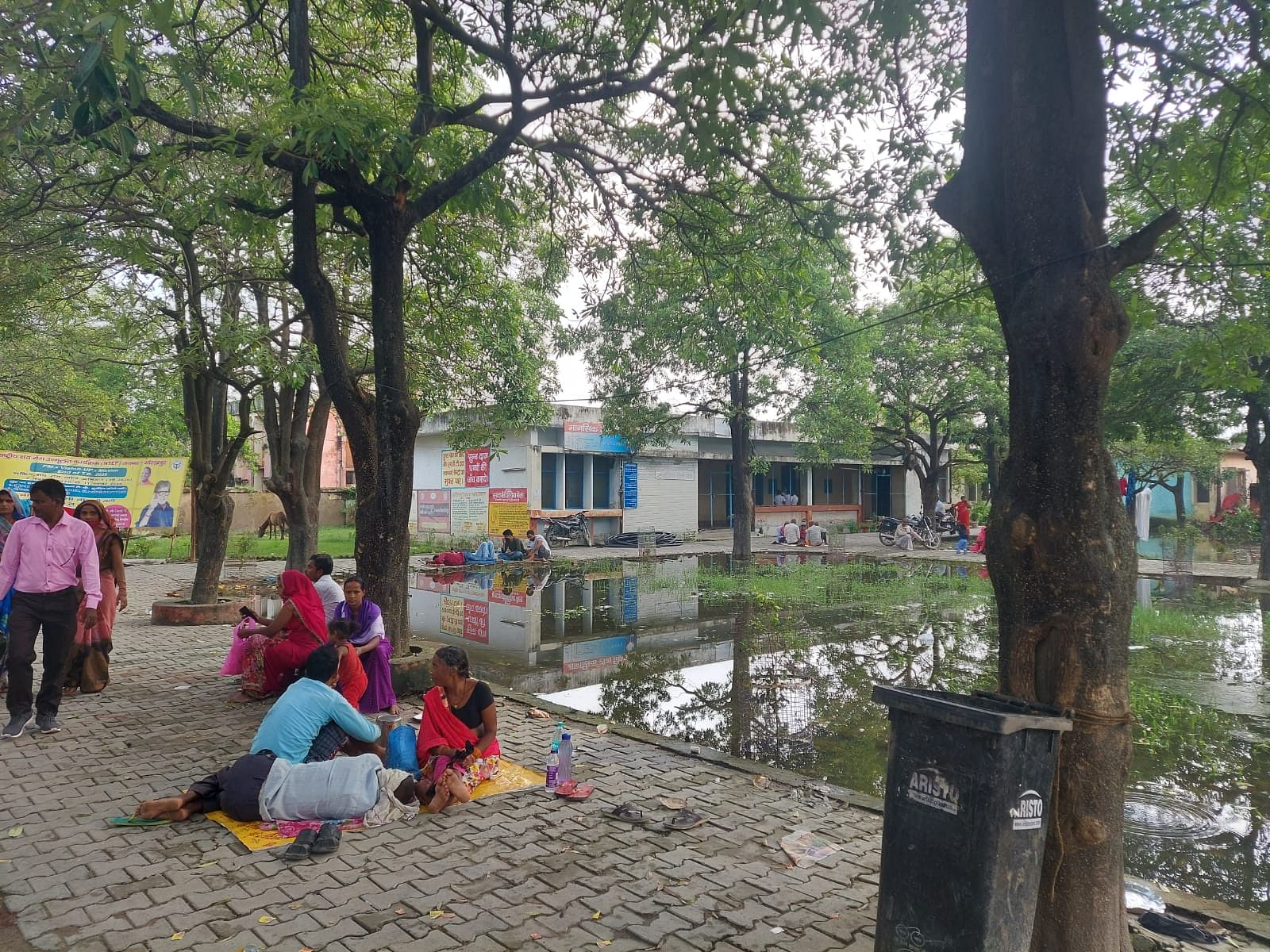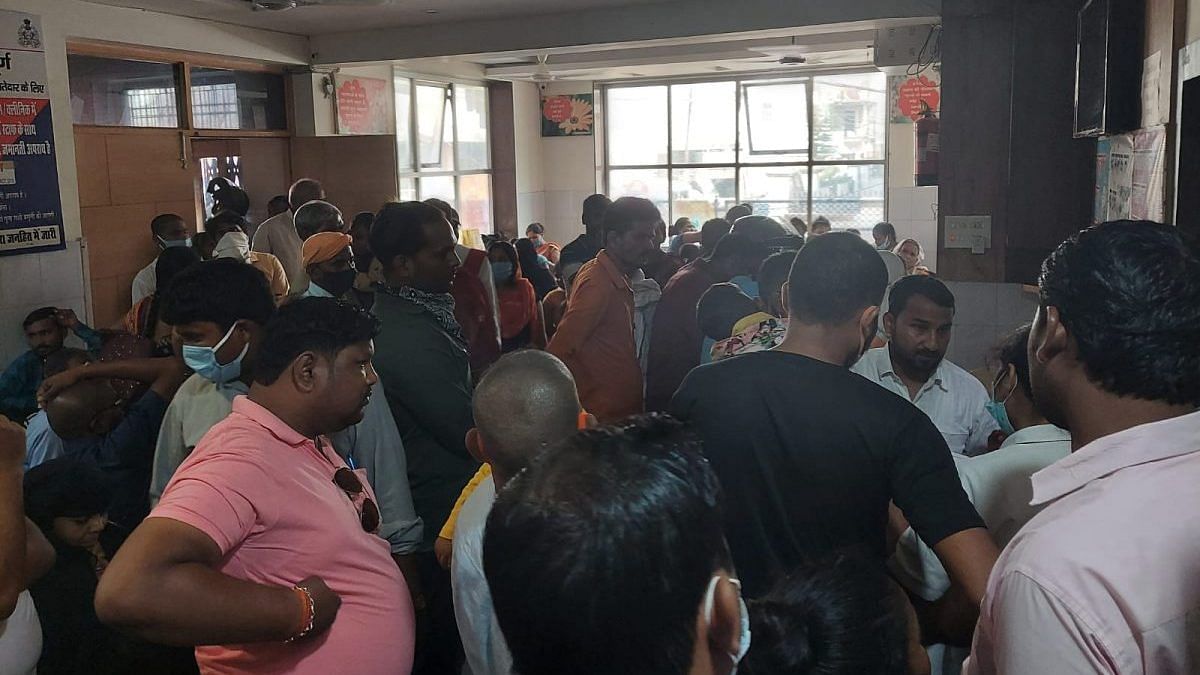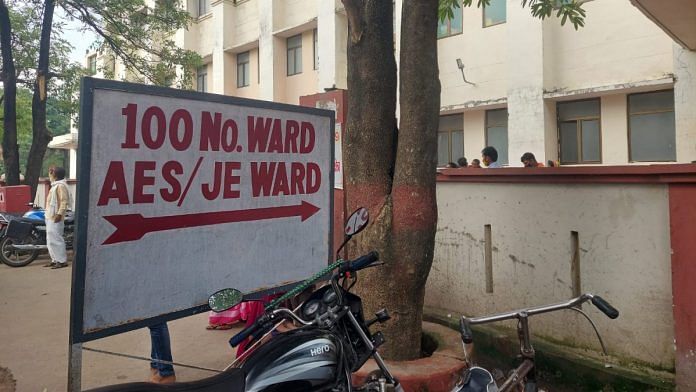Gorakhpur: For 10 days, Umesh Pratap’s 10-year-old daughter Nandini struggled with high fever, before the native of Siwan in Bihar brought her to the BRD Medical College in Uttar Pradesh’s Gorakhpur.
Nandini first showed symptoms on 4 September, complaining of seizures, continuous fever and fatigue.
She now lies unconscious, with half-opened eyes, on a ventilator of the emergency ward at the BRD Medical College.
“She was in a private hospital for six days, but then they asked us to take her to BRD Medical College. We have been here for almost seven days now,” says Pratap, a small shopkeeper with a meagre income of Rs 15,000 per month.
He broke down while explaining that he had already spent Rs 3 lakh on his daughter’s treatment in private hospitals.
Adjacent to Nandini’s bed, three-year-old Sooraj is also unconscious and on a ventilator. His mother Savita, who has come from Kaptanganj, 40 km from Gorakhpur, tends to him.
“He had a fever for 15 days; we took him to a doctor at the local health centre who recommended that we show him to a better doctor,” Savita says. “So, we came to a private hospital and gave him medicines. But after some time, he started having jhatka (seizures), and so we rushed to BRD in Gorakhpur.”
Savita’s husband is a daily wager and works outside Uttar Pradesh. She has come with her brother. “He likes playing in the water. I tried to stop him but he is a kid after all,” cries Savita.
Nandini and Sooraj are part of a phenomenon that has become an annual feature in Gorakhpur, particularly in the months of July, August and September — children in these parts suffering and succumbing to Japanese Encephalitis and Acute Encephalitis Syndrome (AES), a broad term for several infections that afflict them in areas of eastern UP and Bihar.
Symptoms include those of chest infection, diarrhoea, vomiting and mental disorientation.
“AES and Japanese Encephalitis viral infection in children usually presents with acute onset of fever and a change in mental status, including signs like confusion, disorientation or coma and/or new onset of seizures,” states the AES management protocol document developed by the Department of Paediatrics, BRD Medical College, the nodal centre for treatment of AES patients.
According to reports, between 2005 and 2018, 47,509 AES cases were reported in Uttar Pradesh, which led to the death of 8,373 patients. For Japanese Encephalitis, there have been a total of 4,677 cases with 881 deaths in the same period.
This year, Chief Minister Yogi Adityanath has been claiming that the situation is under control. In one rally at Gorakhpur in early September, he claimed that deaths due to Encephalitis had now dipped by 99 per cent.
Last week, he again reiterated, in a tweet, that the situation was under control.
आजादी के बाद कुछ पार्टियों ने अल्पसंख्यकों, अनुसूचित जाति व जनजाति वर्ग के लोगों व उनके बच्चों को सिर्फ वोट बैंक बनाकर रख दिया था।
वर्ष 1977 से 2017 तक हर वर्ष इन्हीं वर्गों के 1500 से 2000 बच्चे इंसेफेलाइटिस के शिकार होते थे, लेकिन किसी ने ध्यान नहीं दिया था।
— Yogi Adityanath (@myogiadityanath) October 6, 2021
The issue has dogged the chief minister for years. For one, Gorakhpur is his home turf — he is the head priest of the Gorkhnath Mutt and has served as the MP here for 19 years.
While the numbers have been decreasing since Adityanath took over the state in 2017, doubts have been cast on the data, even as deaths continue to occur.
According to official data provided by BRD Medical College alone, which sees patients from several districts of Uttar Pradesh and Bihar, there were 2,247 AES patients in 2017, of whom 511 died. The same year, 76 patients died of the 299 admitted with JE.
By 2020, the deaths of AES patients in hospital had dipped to 57 and to 5 in case of JE. That year, 565 AES and 57 JE patients were admitted.
Principal of the BRD Medical College, Ganesh Kumar, told ThePrint that 291 AES patients have been admitted to the hospital this year, of whom 25 have died until the end of September. There have also been 30 cases of JE, Kumar said.
Data accessed by ThePrint, however, shows that this may be an undercount. Every patient admitted at BRD with symptoms of AES is allotted an AES number.
According to this datasheet accessed by ThePrint, until 25 September, 370 patients with AES or JE symptoms were admitted in the hospital, of whom 30 have died. The data also shows that between 14 to 24 September, in a mere 10 days, three children had lost their lives.
But Principal Kumar denied underreporting cases. “Why would we hide the numbers? If we try to hide something, it will be highlighted even more,” he said.
Also read: This is what transpired at Room no. 512 of Gorakhpur hotel where cops ‘killed’ UP businessman
BRD Medical College — a facility under strain
At the BRD Medical College, its ward number 100 is designated for AES patients.
When ThePrint visited last week, the ward and its Paediatric Intensive Care Unit were all full. An adjacent ward, for children who have been discharged from emergency, was also completely full.

Parents and families waited outside the main building of ward 100, with many hailing from the districts of Siddharthnagar, Kushinagar, Deoria, Kaptanganj in Uttar Pradesh and Siwan, Gopalganj, and Bettiah in Bihar.
Despite the crowds, Principal Ganesh Kumar echoed the chief minister and told ThePrint that the situation was under control.
“Ours is a tertiary care centre, whoever comes in serious condition here, we treat them. We have a pediatrics ward of 428 beds and cases of JE/AES have been constantly decreasing under the leadership of CM Yogi,” he said.
Kumar explained that in the months of July, August, and September, when it rains heavily, waterlogging and lack of hygiene results in children here catching such viral diseases.
Gorakhpur Chief Medical Officer (CMO) Sudhakar Pandey also reiterated that the situation is under control. “Cases are very minimal. We have 5 PHCs, 83 medical teams, and 19 mobile teams that visit villages for medical check ups. All of this to treat AES patients,” Pandey said.
Doubts over data
Amid claims of controlled situation and low numbers, suspicion is being raised regarding the authenticity of the data.
A senior doctor associated with BRD Medical College, on condition of anonymity, told ThePrint that there is a possibility that data is being misreported to “please the bosses”.
The doctor also raised suspicion over why Acute Febrile Illness, a fairly new term, is being cited as the cause of death in some children who show symptoms of AES such as seizures.
ThePrint contacted some of the families of those kids who died due to the disease, and their death certificate had AFI mentioned as the disease.
“The hospital has every facility… They are also treating for free, but when the kid dies, nobody is ready to take responsibility or even address it properly,” said a Gorakhpur resident on condition of anonymity whose niece died earlier this year.
“When they admit the child, they will treat it as an AES patient, will also say the child has symptoms of AES, but when he or she dies, they will write some other disease’s name on the certificate,” the resident alleged. :We had a written note from a private hospital doctor that our child had encephalitis and she should be admitted to BRD, but on her death certificate some other disease was mentioned.”
Some other diseases that are being mentioned on the death certificates include Scrub Typhus, Leptospirosis, hyperpyrexia and Acute Bacterial Meningitis.
Dr R.N. Singh, senior pediatrician and former professor at BRD Medical College, explained that these are distinct.
“Acute Febrile Illness has no brain involvement… While AES has fever with alteration of Sensorium with seizures or without seizures,” he said. “AFI may be caused by any bacteria or virus. These days, viral fever, Dengue, Scrub Typhus are mainly being held responsible for it.”

R.N. Singh ran the “AES Unmoolan Abhiyaan”, and was the first person to see a case of Encephalitis in eastern UP in 1977.
Another senior pediatrician and professor from Delhi, who did wish to be named, said, “Febrile means having fever, and acute means short duration; so any short duration fever illness is called AFI. AES often starts like AFI, but they are not the same. If the symptoms are that of AES, which means that along with fever, there is unconsciousness with or without seizures, it technically should not be termed as AFI.”
The doctor added that meninges are coverings of the brain, and when these get infected it’s called Meningitis.
“It is one of the causes of AES, including others such as viral encephalitis, brain TB, cerebral malaria, scrub typhus etc. To detect the causes of AES, lots of facilities are required such as MRIs, blood tests, cerebrospinal fluid tests but these facilities are not available everywhere, so when the exact cause cannot be determined, the umbrella term AES is used,” the doctor told ThePrint.
Gorakhpur CMO Pandey, however, denied obfuscating the cause of death with other diseases. “We have a three-member audit committee that performs a virtual autopsy… If a particular disease is diagnosed, we exclude it from the category of AES,” he said.
“There is some ex-gratia amount given to the relatives of those who die due to AES or JE; so, patients create an issue sometimes to claim that money,” he alleged. “How can a doctors’ team get a diagnosis wrong?”
No admissions in private hospitals
There are a number of private hospitals with paediatrics wards in the city, but apart from the City Hospital, owned by a relative of BJP MLA Kamlesh Paswan, none of them admit patients with AES or JE symptoms.
“No one will tell you the scenario in private hospitals in Gorakhpur; nobody will accept that a problem exists,” a private clinic doctor, on condition of anonymity, told ThePrint. “Even if we see a patient of encephalitis, we immediately refer them to BRD Medical College. Nobody wants to take risks.”

The views were echoed by another former BRD College Official, who also did not wish to be named.
“No one can say anything. There is so much fear going around that they may be put in jail or be suspended. I know that doctors are afraid to write AES as a cause of death,” the official said. “So they write anything. Who can challenge a doctor? In the early 2000s, cases used to peak every three years, but later they began peaking every year. Cases are now comparatively under control though.”
(Edited by Arun Prashanth)
Also read: Broom in hand at Dalit basti, Priyanka takes leaf from Modi 2014 playbook after Yogi jibe



